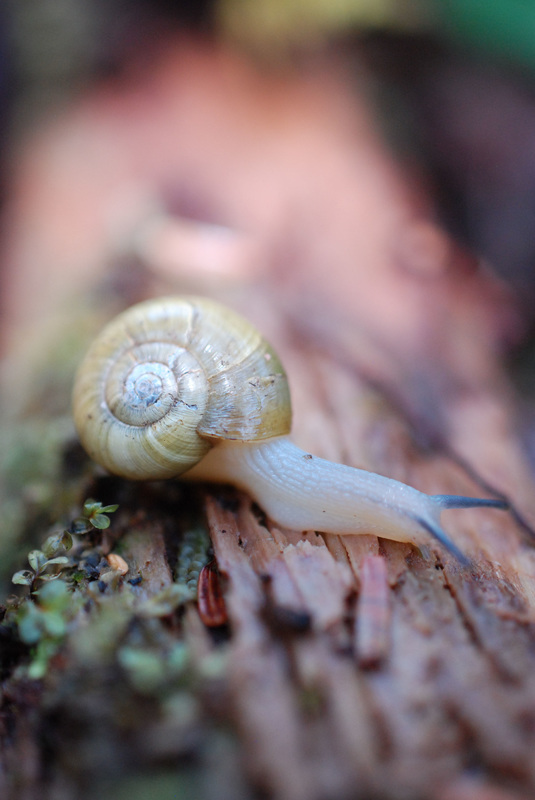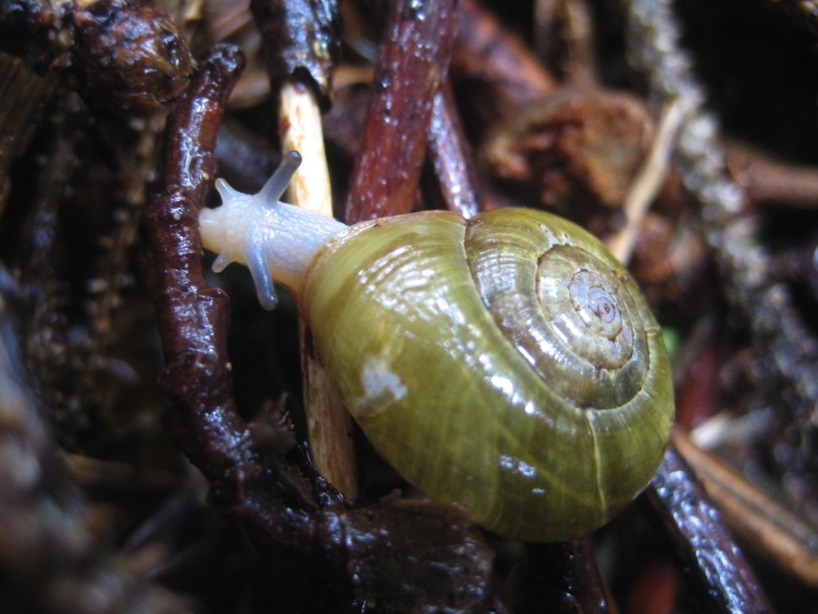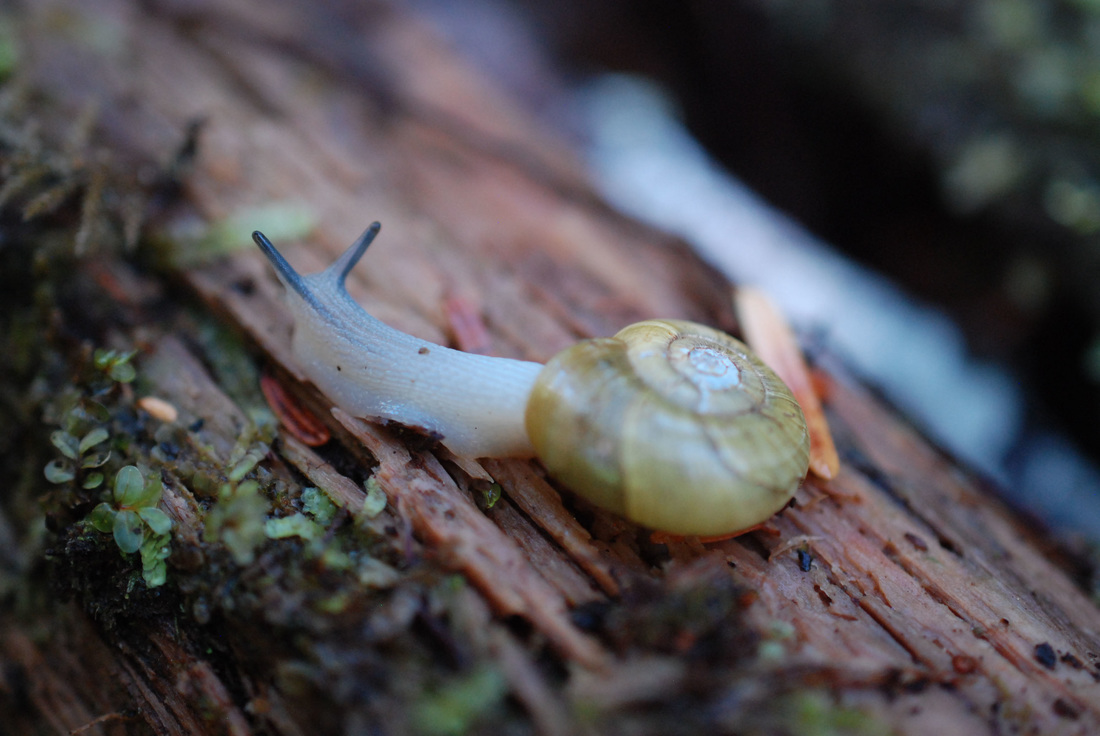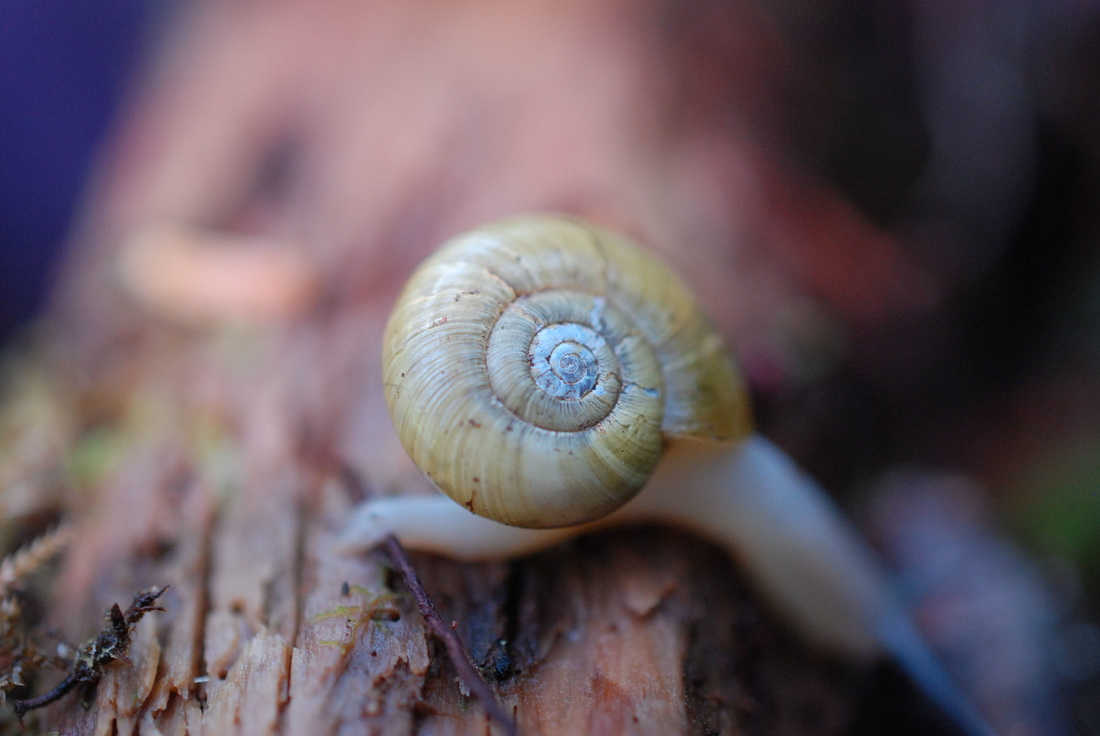Beaded lancetooth • Ancotrema sportella
{ankon = bend/valley; trema = aperture/hole; sportella = "fruit basket," referring to the shell's beaded texture}
Identification
The beaded lancetooth is one of British Columbia's smallest land snails. It has a small (9-22 mm wide) disc-shaped shell that lies fairly flat atop the snail's foot. The shell ranges in colour from straw-yellow to a light green or olive-green. This species gets its name from the way the shell's axial riblets are intersected by spiralling lines to form a bead-like texture. The shell has six whorls, and the last whorl flares outwards slightly. The lip of the aperture is thickened and has a drooping edge (visible in the bottom left shell in this photo). The snail's body is slender and cream-coloured, with a darker head, antennae, and dorsum. This species can be difficult to identify in the field.
Habitat & Range
The beaded lancetooth lives in moist areas, with leaf litter or under logs, vegetation, and rocks. It is most commonly found in deciduous, coniferous, and mixed-wood forests. In BC is is most frequent west of the Coast Mountains, though it can be found in some interior areas of the province. Its range stretches from the Aleutian Islands in Alaska to Humboldt County in California, and stretches eastward into northern Idaho.
Similar Species
The Oregon lancetooth (Ancotrema hybridum) and the robust lancetooth (Haplotrema vancouverense) are both similar to the beaded lancetooth. The robust lancetooth's shell does not have the same beaded texture (its shell is smoother), and its aperture does not droop down like that of the beaded lancetooth (see the upper shell in this photo). The Oregon lancetooth's shell has a similar beading except for the last whorl, which loses this axial structure. Both the Oregon and the robust lancetooth are generally larger than the beaded lancetooth.
Intriguing Info
The variability in size between populations indicates that there may be some as-yet unrecognized subspecies or separate species. Currently one subspecies is recognized in areas of California.
The beaded lancetooth is one of British Columbia's smallest land snails. It has a small (9-22 mm wide) disc-shaped shell that lies fairly flat atop the snail's foot. The shell ranges in colour from straw-yellow to a light green or olive-green. This species gets its name from the way the shell's axial riblets are intersected by spiralling lines to form a bead-like texture. The shell has six whorls, and the last whorl flares outwards slightly. The lip of the aperture is thickened and has a drooping edge (visible in the bottom left shell in this photo). The snail's body is slender and cream-coloured, with a darker head, antennae, and dorsum. This species can be difficult to identify in the field.
Habitat & Range
The beaded lancetooth lives in moist areas, with leaf litter or under logs, vegetation, and rocks. It is most commonly found in deciduous, coniferous, and mixed-wood forests. In BC is is most frequent west of the Coast Mountains, though it can be found in some interior areas of the province. Its range stretches from the Aleutian Islands in Alaska to Humboldt County in California, and stretches eastward into northern Idaho.
Similar Species
The Oregon lancetooth (Ancotrema hybridum) and the robust lancetooth (Haplotrema vancouverense) are both similar to the beaded lancetooth. The robust lancetooth's shell does not have the same beaded texture (its shell is smoother), and its aperture does not droop down like that of the beaded lancetooth (see the upper shell in this photo). The Oregon lancetooth's shell has a similar beading except for the last whorl, which loses this axial structure. Both the Oregon and the robust lancetooth are generally larger than the beaded lancetooth.
Intriguing Info
The variability in size between populations indicates that there may be some as-yet unrecognized subspecies or separate species. Currently one subspecies is recognized in areas of California.
References
Forsyth, R. Ancotrema sportella (Gould, 1846). In Klinkenberg, Brian. (Ed.) E-Fauna BC: Electronic Atlas of the Fauna of British Columbia. Lab for Advanced Spatial Analysis, Department of Geography, University of British Columbia, Vancouver. Accessed 13/03/2014.
Forsyth, R. (2004). Land Snails of British Columbia. Victoria, BC: Royal BC Museum. Pp. 71-72.
Authors and editors of page
Kelly Fretwell and Brian Starzomski (2014).
Forsyth, R. Ancotrema sportella (Gould, 1846). In Klinkenberg, Brian. (Ed.) E-Fauna BC: Electronic Atlas of the Fauna of British Columbia. Lab for Advanced Spatial Analysis, Department of Geography, University of British Columbia, Vancouver. Accessed 13/03/2014.
Forsyth, R. (2004). Land Snails of British Columbia. Victoria, BC: Royal BC Museum. Pp. 71-72.
Authors and editors of page
Kelly Fretwell and Brian Starzomski (2014).







